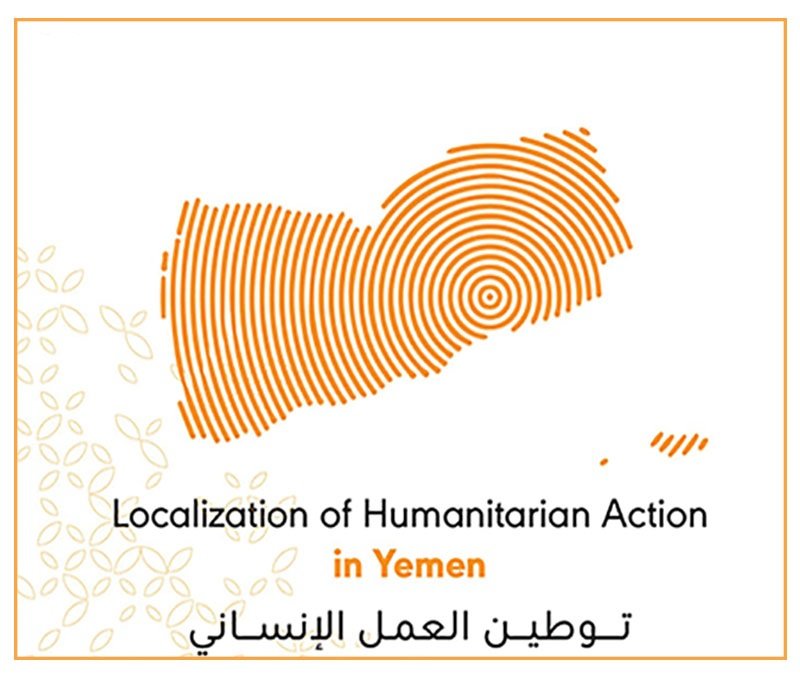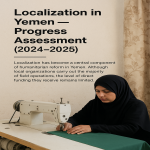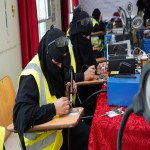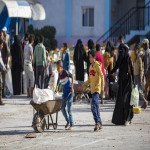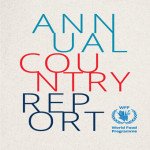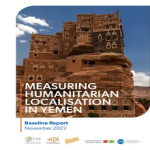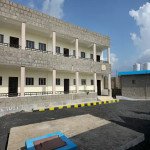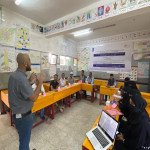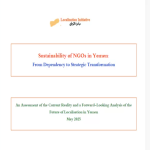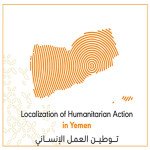قياس أداء التوطين في اليمن 2022
تقرير خط الأساس للتوطين
أدى تدهور الوضع
في اليمن وعدم قدرة المانحين الدوليين على الوفاء بالتزاماتهم المالية لحل الأزمة
الإنسانية إلى اتخاذ مجموعة من المنظمات المدنية المحلية خطوات إضافية لتحسين
فعالية العمل الإنساني. تضمنت إحدى الأولويات التأثير على الجهات الفاعلة الدولية
لدعم (اليمننة Localisation) في العمل الإنساني وتعزيز دور الجهات الفاعلة المحلية.
ونتيجة لذلك ، قدمت شبكة من منظمات المجتمع المدني اليمنية ، بقيادة مؤسسة التمدين
للشباب ، مبادرة (اليمننة Localisation) في العمل الإنساني في اليمن. تم اختيارمؤسسة
اطار للتنمية الاجتماعية كجهة استشارية للقيام ببحوث (اليمننة
Localisation) الأساسية في
اليمن. يقدم هذا التقرير تحليلاً متعمقًا ل (اليمننة
Localisation) في الاستجابة
الإنسانية الحالية في اليمن ، ويعمل كخط أساس للاستجابات المستقبلية ، بما في ذلك
تكييف نهج قياس (اليمننة Localisation) المستخدم في بعض دول منطقة المحيط الهادئ كإطار
قياس مشترك. يتألف التقرير من سبع ركائز رئيسية: الشراكات، التمويل، تعزيز
القدرات، والتنسيق والتكامل، تأثير السياسات، القيادة، والمشاركة.
أدى تدهور الوضع
في اليمن وعدم قدرة المانحين الدوليين على الوفاء بالتزاماتهم المالية لحل الأزمة
الإنسانية إلى اتخاذ مجموعة من المنظمات المدنية المحلية خطوات إضافية لتحسين
فعالية العمل الإنساني. تضمنت إحدى الأولويات التأثير على الجهات الفاعلة الدولية
لدعم (اليمننة Localisation) في العمل الإنساني وتعزيز دور الجهات الفاعلة المحلية.
ونتيجة لذلك ، قدمت شبكة من منظمات المجتمع المدني اليمنية ، بقيادة مؤسسة التمدين
للشباب ، مبادرة (اليمننة Localisation) في العمل الإنساني في اليمن. تم اختيارمؤسسة
اطار للتنمية الاجتماعية كجهة استشارية للقيام ببحوث (اليمننة
Localisation) الأساسية في
اليمن. يقدم هذا التقرير تحليلاً متعمقًا ل (اليمننة
Localisation) في الاستجابة
الإنسانية الحالية في اليمن ، ويعمل كخط أساس للاستجابات المستقبلية ، بما في ذلك
تكييف نهج قياس (اليمننة Localisation) المستخدم في بعض دول منطقة المحيط الهادئ كإطار
قياس مشترك. يتألف التقرير من سبع ركائز رئيسية: الشراكات، التمويل، تعزيز
القدرات، والتنسيق والتكامل، تأثير السياسات، القيادة، والمشاركة.
التوطين في اليمن
على الرغم من
الآثار المدمرة للحرب المستمرة والمجاعة وانعدام الأمن الاقتصادي، تواصل منظمات
المجتمع المدني المحلية بتقديم الدعم المستمر والاستجابة للأزمات المتعددة، نظرًا
لقربها من المجتمع والفئات المتضررة، وفهمها للديناميكيات السياسية والثقافية
والاجتماعية. علاوة على ذلك تواصل منظمات المجتمع المدني المحلية المساهمة بشكل
مباشر في سد احتياجات المستضعفين في اليمن. لقد تبنوا مجموعة من المبادئ الحيوية
لتحقيق السلام الدائم، مثل الدفاع عن حقوق والمساواة، ورفاهية المجتمع، ونبذ العنف
والتطرف. ومع ذلك، لا يزال التحول في مجالات السلطة للمؤسسات المحلية في سياق
الاستجابة الانسانية لليمن يمثلان تحديًا كبيرًا، لا سيما أن الجهات الفاعلة
الدولية (مثل المنظمات غير الحكومية الدولية والأمم المتحدة) تُمنح إمكانية الوصول
إلى موارد أكثر بكثير من نظرائهم المحليين / الوطنيين. في عام 2021، تمكن الصندوق
الإنساني اليمني من تخصيص 109 ملايين دولار لأنشطة برامج الطوارئ، من بينها تلقت
المنظمات غير الحكومية الدولية 54.1 مليون دولار (49٪)، وتلقت وكالات الأمم
المتحدة 24 مليون دولار (22٪) ، والهلال الأحمر حصل على 4.3 دولار. مليون دولار, والجهات الفاعلة المحلية حصلت على
26.7 مليون دولار (24٪) .
أدى عدم التوازن في الحصول على التمويل والموارد المالية،
وتفضيل الجهات المانحة للعمل بشكل مباشر مع الجهات الفاعلة الدولية، إلى إنشاء
نظام مغلق لاتخاذ القرارات المالية والاستراتيجية والبرامجية الذي يحد من المشاركة
النشطة للجهات الفاعلة المحلية والوطنية. تميل معظم أوجه التعاون بين الجهات
الفاعلة الدولية والمحلية / الوطنية إلى أن تكون ذو طابع لا يتسم بالتساوي مع
الجهات الفاعلة الدولية, التي تستفيد من رؤى الجهات الفاعلة المحلية / الوطنية حول
الاحتياجات المحلية. أيضا وجود علاقة تحد من المساءلة المتبادلة والمساءلة تجاه
الأشخاص المتضررين . يبدو أن العديد من المنظمات غير الحكومية الوطنية في اليمن
معرضة بشكل خاص للتهديدات والترهيب والسلوك العدواني من قبل السلطات على جانبي
النزاع.
أفادت التقارير
أن المجتمع المدني اليمني يفتقر إلى الخبرة نسبيًا في العمل مع الشركاء الدوليين
وداخل هياكل تنسيق الشؤون الإنسانية.
يقع الاعتراف
باختلال توازن القوى بين الجهات الفاعلة الوطنية والدولية في صميم أجندة مبادرة
اليمننة
تعتبر المنظمات غير الحكومية نفسها بشكل منتظم في وضع غير
مؤات، ويرجع ذلك في المقام الأول إلى اعتماد الجهات الفاعلة الوطنية على نظيراتها
الدولية للحصول على الموارد والدعم الفني. كما تم الإبلاغ عن تدخلات متكررة وقوية
في كثير من الأحيان من قبل الممثلين الدوليين الذين تم اعتبارهم "خبراء
تقنيين" كعامل يحد من المشاركة الوطنية الفاعلة، والثقة المتبادلة والقيادة.
وقد تضاعفت هذه الديناميكيات في بلدان مثل اليمن حيث لم يكن المانحون موجودين في
بلد العمل. لذلك لم يكن لدى المنظمات غير الحكومية وصول مباشر إلى الجهات المانحة
المؤسسية، وكثيراً ما اعتمدت بدلاً من ذلك على وكالات الأمم المتحدة والمنظمات غير
الحكومية الدولية لتمرير الرسائل والدعوة نيابة عنها .
أصبحت اليمننة
‘Localisation’ أكثر أهمية لضمان
تقديم المساعدة بشكل أكثر فعالية وكفاءة للمجتمعات المتضررة بطريقة تضعهم في مركز
التخطيط والتسليم ، فإنه يُنظر إليه أيضًا على أنه إجراء تصحيحي مهم للمسار
لمعالجة اختلالات القوة في النظام. هناك اعتراف متزايد في اليمن بالحاجة إلى تبني
وتطبيق اليمننة ‘Localisation’ بشكل أكثر قوة ،
مدفوعًا بتصميم متزايد من المجتمع المدني المحلي لإنشاء نموذج استجابة انسانية
بقيادة محلية. كما أظهرت سياقات دول أخرى ، لا يزال إحراز تقدم في اليمننة
‘Localisation’ يمثل تحديًا يتطلب تغييرًا منهجيًا في المواقف
والممارسات والأنظمة. يمكن أن يؤدي فهم حالة اليمننة
‘Localisation’ في الدولة والفرص المتاحة لإحراز تقدم إلى خلق
زخم تشتد الحاجة إليه للدعوة المستهدفة والعمل الجماعي.
على الرغم من
الآثار المدمرة للحرب المستمرة والمجاعة وانعدام الأمن الاقتصادي، تواصل منظمات
المجتمع المدني المحلية بتقديم الدعم المستمر والاستجابة للأزمات المتعددة، نظرًا
لقربها من المجتمع والفئات المتضررة، وفهمها للديناميكيات السياسية والثقافية
والاجتماعية. علاوة على ذلك تواصل منظمات المجتمع المدني المحلية المساهمة بشكل
مباشر في سد احتياجات المستضعفين في اليمن. لقد تبنوا مجموعة من المبادئ الحيوية
لتحقيق السلام الدائم، مثل الدفاع عن حقوق والمساواة، ورفاهية المجتمع، ونبذ العنف
والتطرف. ومع ذلك، لا يزال التحول في مجالات السلطة للمؤسسات المحلية في سياق
الاستجابة الانسانية لليمن يمثلان تحديًا كبيرًا، لا سيما أن الجهات الفاعلة
الدولية (مثل المنظمات غير الحكومية الدولية والأمم المتحدة) تُمنح إمكانية الوصول
إلى موارد أكثر بكثير من نظرائهم المحليين / الوطنيين. في عام 2021، تمكن الصندوق
الإنساني اليمني من تخصيص 109 ملايين دولار لأنشطة برامج الطوارئ، من بينها تلقت
المنظمات غير الحكومية الدولية 54.1 مليون دولار (49٪)، وتلقت وكالات الأمم
المتحدة 24 مليون دولار (22٪) ، والهلال الأحمر حصل على 4.3 دولار. مليون دولار, والجهات الفاعلة المحلية حصلت على
26.7 مليون دولار (24٪) .
أدى عدم التوازن في الحصول على التمويل والموارد المالية،
وتفضيل الجهات المانحة للعمل بشكل مباشر مع الجهات الفاعلة الدولية، إلى إنشاء
نظام مغلق لاتخاذ القرارات المالية والاستراتيجية والبرامجية الذي يحد من المشاركة
النشطة للجهات الفاعلة المحلية والوطنية. تميل معظم أوجه التعاون بين الجهات
الفاعلة الدولية والمحلية / الوطنية إلى أن تكون ذو طابع لا يتسم بالتساوي مع
الجهات الفاعلة الدولية, التي تستفيد من رؤى الجهات الفاعلة المحلية / الوطنية حول
الاحتياجات المحلية. أيضا وجود علاقة تحد من المساءلة المتبادلة والمساءلة تجاه
الأشخاص المتضررين . يبدو أن العديد من المنظمات غير الحكومية الوطنية في اليمن
معرضة بشكل خاص للتهديدات والترهيب والسلوك العدواني من قبل السلطات على جانبي
النزاع.
أفادت التقارير
أن المجتمع المدني اليمني يفتقر إلى الخبرة نسبيًا في العمل مع الشركاء الدوليين
وداخل هياكل تنسيق الشؤون الإنسانية.
يقع الاعتراف
باختلال توازن القوى بين الجهات الفاعلة الوطنية والدولية في صميم أجندة مبادرة
اليمننة
تعتبر المنظمات غير الحكومية نفسها بشكل منتظم في وضع غير
مؤات، ويرجع ذلك في المقام الأول إلى اعتماد الجهات الفاعلة الوطنية على نظيراتها
الدولية للحصول على الموارد والدعم الفني. كما تم الإبلاغ عن تدخلات متكررة وقوية
في كثير من الأحيان من قبل الممثلين الدوليين الذين تم اعتبارهم "خبراء
تقنيين" كعامل يحد من المشاركة الوطنية الفاعلة، والثقة المتبادلة والقيادة.
وقد تضاعفت هذه الديناميكيات في بلدان مثل اليمن حيث لم يكن المانحون موجودين في
بلد العمل. لذلك لم يكن لدى المنظمات غير الحكومية وصول مباشر إلى الجهات المانحة
المؤسسية، وكثيراً ما اعتمدت بدلاً من ذلك على وكالات الأمم المتحدة والمنظمات غير
الحكومية الدولية لتمرير الرسائل والدعوة نيابة عنها .
أصبحت اليمننة
‘Localisation’ أكثر أهمية لضمان
تقديم المساعدة بشكل أكثر فعالية وكفاءة للمجتمعات المتضررة بطريقة تضعهم في مركز
التخطيط والتسليم ، فإنه يُنظر إليه أيضًا على أنه إجراء تصحيحي مهم للمسار
لمعالجة اختلالات القوة في النظام. هناك اعتراف متزايد في اليمن بالحاجة إلى تبني
وتطبيق اليمننة ‘Localisation’ بشكل أكثر قوة ،
مدفوعًا بتصميم متزايد من المجتمع المدني المحلي لإنشاء نموذج استجابة انسانية
بقيادة محلية. كما أظهرت سياقات دول أخرى ، لا يزال إحراز تقدم في اليمننة
‘Localisation’ يمثل تحديًا يتطلب تغييرًا منهجيًا في المواقف
والممارسات والأنظمة. يمكن أن يؤدي فهم حالة اليمننة
‘Localisation’ في الدولة والفرص المتاحة لإحراز تقدم إلى خلق
زخم تشتد الحاجة إليه للدعوة المستهدفة والعمل الجماعي.
ملخص النتائج الرئيسية
ترتيب ابرز (12)
أولويات توطين وتحسين آليات الاستجابة في اليمن بحسب نتائج التقييم للفاعلين
المحليين
1
زيادة حجم التمويل للفاعلين المحليين
2
القرارات بشأن المسائل المالية المحلية والوطنية
3
دعم وتعزيز القيادة الوطنية للاستجابة
4
تأثير الجهات الفاعلة المحلية والوطنية في أولويات المانحين
في البلد
5
تمويل آليات التنسيق الوطنية للمجتمع المدني
6
حق القرار في الشراكات
7
الشراكات الإستراتيجية
8
التشريعات والخطط القائمة لدعم قدرة الاستجابة الوطنية
9
عمل الجهات الدولية مع هياكل وآليات القيادة داخل الدولة
واحترامها
10
الجهات الفاعلة الوطنية كأصحاب مصلحة رئيسيين في المناقشات
الوطنية
11
التمويل المباشر
12
القدرة الوطنية والإقليمية على مواجهة الكوارث المفاجئة
ترتيب ابرز (12)
أولويات توطين وتحسين آليات الاستجابة في اليمن بحسب نتائج التقييم للفاعلين
المحليين
1
زيادة حجم التمويل للفاعلين المحليين
2
القرارات بشأن المسائل المالية المحلية والوطنية
3
دعم وتعزيز القيادة الوطنية للاستجابة
4
تأثير الجهات الفاعلة المحلية والوطنية في أولويات المانحين
في البلد
5
تمويل آليات التنسيق الوطنية للمجتمع المدني
6
حق القرار في الشراكات
7
الشراكات الإستراتيجية
8
التشريعات والخطط القائمة لدعم قدرة الاستجابة الوطنية
9
عمل الجهات الدولية مع هياكل وآليات القيادة داخل الدولة
واحترامها
10
الجهات الفاعلة الوطنية كأصحاب مصلحة رئيسيين في المناقشات
الوطنية
11
التمويل المباشر
12
القدرة الوطنية والإقليمية على مواجهة الكوارث المفاجئة
التطلع إلى الأمام - الخطوات الرئيسية والفرص والتوصيات
تشير نتائج بحث
الأساس هذا إلى أن التقدم المحرز في توطين الاستجابة في اليمن بطيء في الاستجابة
الإنسانية الراهنة في اليمن أو غير مرئي ،
ولكن لا يزال هناك مجال لمزيد من التحسين و البناء على الفرص و التقدم المحرز حتى
الان خاصة بعض الفرص للاستفادة من المشاركة الهادفة للجهات الفاعلة المحلية في
القيادة وعملية صنع القرار مع الانخراط بقوة في جهود الدعوة الجماعية والسياسات.
ظهرت أيضًا بعض مجالات التعزيز. يمكن تكرار هذه الدراسة
لتقييم الاستجابة المستقبلية باستخدام إطار اليمننة
‘Localisation’ ونهج القياس. استنادًا إلى نتائج التقييم
الأساسي للاستجابة في اليمن، يوصى باتخاذ إجراءات في المجالات الأربعة التالية
للمضي قدمًا في العمل بشأن اليمننة ‘Localisation’:
1.
إنشاء هيكل لتسهيل اليمننة
‘Localisation’ ورصد التقدم ومراقبتها
1
تعزيز اليمننة ‘Localisation’ في آليات التنسيق والاستجابة الحالية
2.
تعزيز إجراءات اليمننة
‘Localisation’ في الاستجابة للجهات الفاعلة والجهات المانحة
الدولية
3.
زيادة فرص الجهات الفاعلة المحلية والوطنية للاستجابة بشكل
أكثر فعالية.
تشير نتائج بحث
الأساس هذا إلى أن التقدم المحرز في توطين الاستجابة في اليمن بطيء في الاستجابة
الإنسانية الراهنة في اليمن أو غير مرئي ،
ولكن لا يزال هناك مجال لمزيد من التحسين و البناء على الفرص و التقدم المحرز حتى
الان خاصة بعض الفرص للاستفادة من المشاركة الهادفة للجهات الفاعلة المحلية في
القيادة وعملية صنع القرار مع الانخراط بقوة في جهود الدعوة الجماعية والسياسات.
ظهرت أيضًا بعض مجالات التعزيز. يمكن تكرار هذه الدراسة
لتقييم الاستجابة المستقبلية باستخدام إطار اليمننة
‘Localisation’ ونهج القياس. استنادًا إلى نتائج التقييم
الأساسي للاستجابة في اليمن، يوصى باتخاذ إجراءات في المجالات الأربعة التالية
للمضي قدمًا في العمل بشأن اليمننة ‘Localisation’:
1.
إنشاء هيكل لتسهيل اليمننة
‘Localisation’ ورصد التقدم ومراقبتها
1
تعزيز اليمننة ‘Localisation’ في آليات التنسيق والاستجابة الحالية
2.
تعزيز إجراءات اليمننة
‘Localisation’ في الاستجابة للجهات الفاعلة والجهات المانحة
الدولية
3.
زيادة فرص الجهات الفاعلة المحلية والوطنية للاستجابة بشكل
أكثر فعالية.

